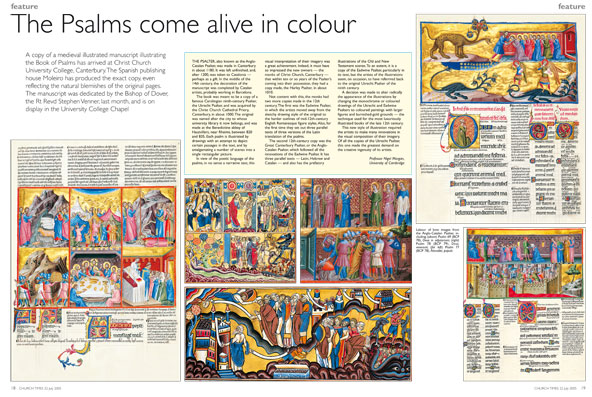The Psalms come alive in colour
A copy of a medieval illustrated manuscript illustrating the Book of Psalms has arrived at Christ Church University College, Canterbury. The Spanish publishing house Moleiro has produced the exact copy, even reflecting the natural blemishes of the original pages. The manuscript was dedicated by the Bishop of Dover, the Rt Revd Stephen Venner, last month, and is on display in the University College Chapel.
THE PSALTER, also known as the Anglo-Catalan Psalter, was made in Canterbury in about 1180. It was left unfinished, and,after 1200, was taken to Catalonia - perhaps as a gift. In the middle of the14th century, the decoration of the manuscript was completed by Catalan artists, probably working in Barcelona. The book was meant to be a copy of a famous Carolingian ninth-century Psalter, the Utrecht Psalter, and was acquired by the Christ Church Cathedral Priory, Canterbury, in about 1000. The original was named after the city to whose university library it now belongs, and was made at the Benedictine abbey of Hautvillers, near Rheims, between 820 and 835. Each psalm is illustrated by drawings with an attempt to depict certain passages in the text, and by amalgamating a number of scenes into a single rectangular picture. In view of the poetic language of the psalms, in no sense a narrative text, this visual interpretation of their imagery was a great achievement. Indeed, it must have so impressed the new owners - the monks of Christ Church, Canterbury - that within ten or so years of the Psalter's coming into their possession, they had acopy made, the Harley Psalter, in about 1010. Not content with this, the monks had two more copies made in the 12th century. The first was the Eadwine Psalter, in which the artists moved away from the sketchy drawing style of the original to the harder outlines of mid-12th-century English Romanesque figure styles. Also, for the first time they set out three parallel texts of three versions of the Latin translation of the psalms. The second 12th-century copy was the Great Canterbury Psalter, or the Anglo-Catalan Psalter, which followed all the innovations of the Eadwine Psalter. It has three parallel texts - Latin, Hebrew and Catalan - and also has the prefatory illustrations of the Old and New Testament scenes. To an extent, it is a copy of the Eadwine Psalter, particularly in its text, but the artists of the illustrations seem, on occasion, to have referred back to the original Utrecht Psalter of the ninth century. A decision was made to alter radically the appearance of the illustrations by changing the monochrome or coloured drawings of the Utrecht and Eadwine Psalters to coloured paintings with larger figures and burnished-gold grounds - the technique used for the most luxuriously illustrated books of the late 12th century. This new style of illustration required the artists to make many innovations in the visual composition of their imagery. Of all the copies of the Utrecht Psalter, this one made the greatest demand onthe creative ingenuity of its artists.
Professor Nigel Morgan, University of Cambridge
